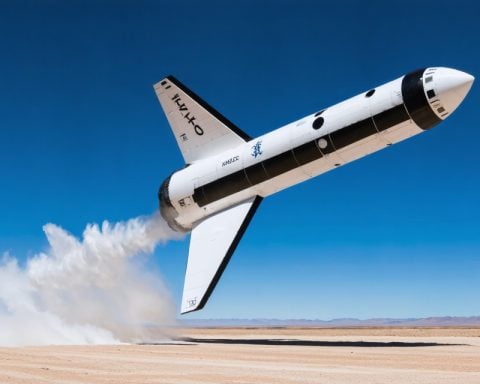- SpinLaunch utilizes a mechanical catapult to launch satellites at speeds of 5,000 mph.
- The technology leverages kinetic energy, eliminating the need for traditional rocket fuel.
- Launch costs could be reduced by up to ten times compared to conventional rockets.
- This method allows for quicker turnaround times and significantly lowers carbon emissions.
- Successful tests and backing from major players like NASA and Airbus bolster SpinLaunch’s prospects.
- A full-scale orbital launch system is projected to be operational by 2026.
- There is a competitive landscape with established companies like SpaceX, focusing on lightweight payloads.
Prepare for lift-off! California-based SpinLaunch is bringing thrilling innovation to space exploration with a colossal mechanical catapult that’s set to redefine satellite launches. Imagine a technology that harnesses kinetic energy to send satellites soaring into orbit at a staggering 5,000 mph—all while cutting out rocket fuel!
This radical approach is not just about speed; it’s about making space travel affordable and eco-friendly. By spinning payloads in a vacuum-sealed centrifuge and releasing them at hypersonic speeds, SpinLaunch slashes launch costs by a jaw-dropping up to ten times compared to conventional rockets. On top of that, it promises a quicker turnaround time and a significant reduction in carbon emissions, paving the way for a sustainable future in space.
With successful test launches and support from industry giants like NASA and Airbus, SpinLaunch aims to have a full-scale orbital launch system operational by 2026. This innovation could be a game-changer for small satellite operators eager for cost-effective access to the cosmos.
However, the question remains: Can SpinLaunch compete with established players like SpaceX? As they target lightweight payloads, the potential for disruption is enormous, hinting at a new era of space exploration that combines speed with sustainability.
Keep your eyes on the stars—SpinLaunch could usher in a thrilling chapter in our quest to reach the universe! The future of satellite launches may very well be spinning towards us.
SpinLaunch: The Future of Affordable and Eco-Friendly Space Travel!
Introducing SpinLaunch’s Innovative Launch System
California-based SpinLaunch is revolutionizing space exploration with its groundbreaking mechanical catapult technology. This impressive system is designed to launch satellites into orbit at breathtaking speeds of 5,000 mph by utilizing kinetic energy, ultimately reducing the need for traditional rocket fuel. The implications for the space industry are enormous, as this method could bring down launch costs by up to ten times compared to conventional rockets, making space travel more accessible and eco-conscious.
Features and Innovations
1. Kinetic Energy Powered Launch: By spinning payloads in a vacuum-sealed centrifuge, SpinLaunch utilizes kinetic energy to propel satellites into orbit. This system is both innovative and resource-efficient.
2. Cost-Efficiency: The projected cost reduction of up to 90% in launch expenses could democratize access to space for small satellite operators, allowing for more frequent and affordable launches.
3. Environmental Impact: SpinLaunch’s approach significantly lowers carbon emissions associated with rocket launches, addressing the growing concern over the environmental impact of space travel.
4. Faster Turnaround Times: The mechanical catapult may enable quicker launch cycles compared to traditional rocket systems, increasing the responsiveness of satellite deployment.
Limitations and Challenges
– Payload Weight: SpinLaunch is primarily designed for lightweight payloads, which might limit its applicability for heavier satellite missions.
– Technical Challenges: Ensuring the safety and reliability of the mechanical catapult technology in real-world conditions remains a critical hurdle that needs to be addressed.
– Competition: Established players like SpaceX have extensive experience and infrastructure, posing a significant challenge for SpinLaunch as it works to carve out its niche.
Pricing Outlook
While detailed pricing structures are still under wraps, the potential for reducing launch costs dramatically suggests that SpinLaunch could offer competitive pricing, enticing small and medium-sized satellite operators to utilize their services instead of conventional methods.
Key Questions
1. How does SpinLaunch compare to traditional rocket systems?
SpinLaunch offers a radical alternative by eliminating the use of rocket fuel and dramatically cutting launch costs. Its mechanical catapult technology is designed primarily for lightweight payloads, focusing on high-speed launches.
2. What are the environmental benefits of SpinLaunch’s technology?
By reducing reliance on fuel and emissions, SpinLaunch’s kinetic energy-based technology aims to minimize the environmental impact associated with satellite launches, promoting a more sustainable approach to space exploration.
3. When can we expect operational readiness of SpinLaunch’s launch system?
SpinLaunch plans to have a full-scale orbital launch system operational by 2026, with successful initial test launches already completed, and significant backing from industry leaders like NASA and Airbus.
Market Insights
The rise of SpinLaunch aligns with growing trends in the space sector that prioritize sustainability and affordability. As the demand for satellite launches increases, innovations like SpinLaunch could play a pivotal role in supporting the burgeoning small satellite industry.
For more information on SpinLaunch and its impact on the space industry, check out SpinLaunch’s official website.

















